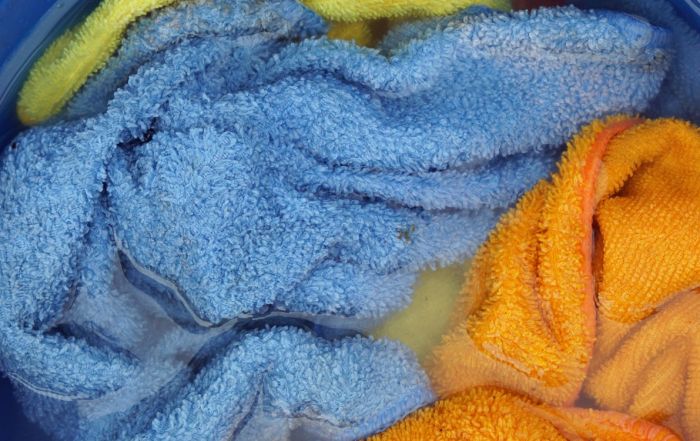Sanitation, Sanitation, Where Art Thou?
Continuing the theme I picked up on a few months ago, discussing common causes of foodborne illness, I’d like to focus this blog on cross contamination, more precisely sanitation. Sanitation is another issue that employees don’t often do at home, so they discount the importance of it in the food production environment. That is to say that they have never made someone sick at home because they only clean their countertops and they have likely never sanitized their kitchen, so why is it so important in a foodservice facility?
If you want to see how seriously your employees take sanitation, look no further than the first thing they do when they start production in the morning. Do employees start food production upon first arriving in the morning or do they take time to sanitize all the work surfaces before starting production? This may seem like an unnecessary step, especially in operations where there may only be one production shift, like in a school system. However, you can never really be too sure of what occurred during the evening when no one was using the space. Was a maintenance person working in the area with their work bag on the table? Did an after-hours delivery drive place boxes that were sitting outside on the ground on the preparation table? Did a rodent or cockroach (although we hate to think of this – it does happen) run across the table in the wee hours of the morning? Or perhaps the staff the day before didn’t really sanitize as well as they had thought they did.
If you want to see how seriously your employees take sanitation, look no further than the first thing they do when they start production in the morning…do they take time to sanitize all the work surfaces before starting production?
Often, our employees like to show off their clean kitchens, and certainly a clean kitchen is something to be proud of. Afterall, it cannot be sanitized if it is not first clean. However, we must be sure to educate our employees that we cannot stop at clean. We must be mindful to sanitize property and avoid cross contamination. A few years ago, we placed a camera in a school to watch sanitation practices and were surprised as what we found at the end of the day. We’ve released the video and use it in training to help employees understand the importance of cleaning vs. sanitizing and have made it available online free of charge.
Be certain your employees are also aware of the sanitizer you use in your facility –on surfaces and within the three-compartment sink and/or dishwasher. They need to know what product to use, but also the specifics about the product – how to mix it, proper strength, the amount of contact time for it to be effective, and how to properly utilize test strips to ensure that the concentration is correct.
Once you are sure your employees are knowledgeable about your sanitizers, the tricky part is ensuring that they use them when they are supposed to do so. This is again where that culture of food safety comes into play. As a manager, you cannot be everywhere all the time, so you must have a supportive environment where employees are able to remind other employees to properly sanitize surfaces or equipment when they see that it has not been done correctly. Allowing all employees to hold each other accountable in a supportive environment will go a long way to not only providing the safe food culture, but also ensuring guest satisfaction and safety throughout your organization.
Late last week, we released our second SafeBites Webinar of 2022. In the webinar, Dr. Ellen Shumaker, who directs the outreach and extension activities for the Safe Plates program at North Carolina State University, discusses food safety messaging and the role of food safety culture in shaping employee and organizational behaviors. This is the second release of our new on-demand webinar, please drop me a note and let me know if you enjoy the new format or not. Risk Nothing.
READ MORE POSTS
Embracing Technology for Enhanced Food Safety in Foodservice Operations
Technology. We love it, we hate it. I’ve always been fascinated by technology; I remember getting my first Blackberry in the mid-90s and thinking it was the pinnacle of technological advances. Before that, I remember ordering a dictation program in college that was going to revolutionize the way I “typed” my assignments. Looking back, it really wasn’t worth the box that the program came in. Now, we have ChatGPT that will write the entire paper for us!
Meat Color and Doneness: Persistent Pinking
Late in June, my family and I were able to visit the Black Hills, an area of the country in which I have not had the opportunity to spend much time. One evening, as we dined at a local restaurant, I observed a table across the dining room sending back a dinner. While I couldn’t hear the entire conversation and I certainly wasn’t trying to eavesdrop, it was apparent that the customer was unhappy with the cooking of their hamburger and was sending it back because it was too pink in the middle. That immediately brought to my mind the phenomenon known as persistent pinking. A term I became familiar with because of work done by some colleagues here at Kansas State, which they present each summer to a group of foodservice operators who join us on-campus for an in-depth week-long look at all things food safety.
Quat Binding – Why this Can Have a Disastrous Impact on Your Sanitation Program.
In June, I had the opportunity to represent FoodHandler and speak on food safety behavior for customers of Martin Bros. Distributing in Waterloo, Iowa. One of the questions that was asked caught me a little off guard. The question was about quat binding. It caught me off guard not because it was a bad question, but only because it was not something I had previously been asked nor had not yet been exposed to the phenomenon. However, I soon learned that in certain jurisdictions, it is resulting in changes to how sanitizing cloths are to be stored in sanitizing buckets (or not) in the foodservice industry. When I returned home from the trip, I had to dig into it to learn about what quat binding is and how it might impact foodservice operations.
Are Grades for Foodservice Inspections a Good Idea?
I generally try to stay away from controversial topics in my blog, but this is one I thought it might be interesting to discuss. Occasionally on my travels, I will come across a state or a local jurisdiction that requires foodservice inspection scores be posted in the window of the establishment. The idea is to allow would-be customers the ability to see how the foodservice operation in which they are about to eat scored on their latest health inspection.










